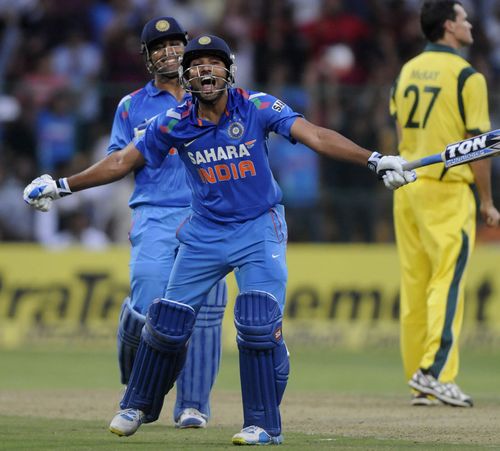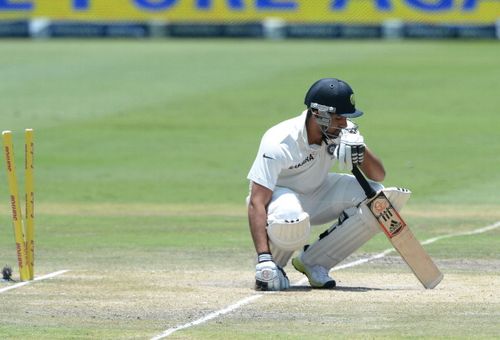
The ground reality of Indian cricket - stadiums and numbers

The India-Australia series last year showed how pathetic the situation is for bowlers in India
Something quite peculiar happened on 13th November 2003. India were playing Pakistan at Eden Gardens in a one off limited overs contest to celebrate 75 years of the BCCI.
Batting first, India scored an imperious 292 in their allotted overs. A total in excess of 200 had not been chased successfully at the ground in over twelve years. Eden Gardens pitch was known to deteriorate rapidly in the second innings, as India quite famously found out in the semi finals of the ’96 World Cup. A total in excess of 200 had been chased successfully only 4 times in the previous 14 occasions. To make it stiffer, a total in excess of 250 had been chased just once!
Engulfed by that famous Calcutta smog, Pakistan coolly chased down 293 and won the game on a canter, with an over to spare. That match set me thinking about the pitch in that hallowed turf of Eden gardens.
This was the same turf on which Tendulkar magically saved India the blushes by bowling an impeccable final over against South Africa in the Hero Cup semi final in 1993. A few days later in the finals, Anil Kumble ran through the West Indies lineup and ended up with outrageous figures of 6/12, which at that time were the third best figures in limited overs cricket.
Since that day, 20 matches have been played and 8 hundreds scored and totals in excess of 250 have been set and chased with consummate ease. In the 17 matches before that day, a mere 4 hundreds were scored. Eden Gardens slowly started shifting from being one of the best One Day venues, and suddenly started going mainstream. So what went wrong?
As Indians, we like to fuss over our pitches. In an era when scores in excess of 300 are being chased down with alarming regularity and when the fielding restrictions are being turned against the bowlers, the pitches deserve some scrutiny from us.
The India-Australia series last year was in the news for a lot of reasons. I conducted a small study in contrast between two series, India v Australia in India and Pakistan v South Africa in the UAE.
The two series make for some astounding stats:
- In the five matches that reached their conclusion in India, the top 6 batsmen from both teams amassed an eye popping 2725 runs at 55 per wicket. A hop, skip and a jump across the Arabian Sea in the UAE, the top 6 Pakistani and South African batsmen were able to score a mere 1556 runs at a paltry 26 per wicket.
- The Indian series saw 7 hundreds, one double hundred, 13 fifties, 287 fours and 76 sixes from the top six batsmen. The UAE series, on the other hand, saw just 2 hundreds, 7 fifties, less than 150 fours and a mere 13 sixes.
- The 8 hundreds recorded in the India-Aus series were the most ever in any bilateral series.
- The batting averages are also the highest for any bilateral series featuring five or more matches. So was the strike rate.
- The bowlers were unfortunately whacked all over the place and a total in excess of three hundred was conceded in nine of the ten innings!
- The bowling average stood at 54, which was the worst for any bilateral series. The economy rate of the bowlers too was an incredible 6.5.
- There were no five wicket hauls in the Ind-Aus series. There was just 1 four wicket haul. In the UAE, there were 3 four wickets hauls and 1 five-for.
God knows what else might’ve happened if those two games at Cuttack and Ranchi had not been washed out.
All this points to a greater malaise. We surely have to point fingers at the kind of wickets that are being prepared in this country because the very same bowling Aussie attack tore England to shreds Down Under. There is no denying the fact that low scoring matches do make for exceptionally good viewing. The occasional high scoring game does add a bit to the flavour. But an overdose of either high scoring or low scoring games kills the joy.
The general argument made on TV is that a batsman’s skillset can be viewed in all its glory on a spiteful wicket where run making is difficult. But should the same logic be applied to bowlers by saying that the bowler must show us how good he is on a batting friendly wicket. I somehow do not conform to that view. Let me justify why. I shall speak purely with limited overs cricket in mind.
Gone are the days when the MCG would have boundaries that were longer than 100m. So a batsman had to be exceptionally well built to hit it out of the playing area. Post renovation, the boundaries were brought in and all run fours have become all but extinct. In India, boundaries rarely stretch beyond eighty meters. That, combined with the nasty fielding restrictions and dreadful wickets are conspiring to make limited overs cricket a sad affair for the bowlers.
A deeper analysis of the stats gives us a clear picture of all that is wrong with Indian wickets. Post the 2011 World Cup, batsmen average the highest when playing in India (at 34.77 per wicket). Indian crowds have witnessed more centuries, fifties, fours and sixes than crowds in any other cricket watching nation. Bowling averages in India are the highest (at nearly 39 per wicket) when compared with other countries that have hosted a minimum of ten matches since the World Cup. Poor chaps have picked just 1 five wicket haul in nearly three years.
But one might ask, what really is the fuss about? India are still second from the top (They just lost their top rank after yet another loss to New Zealand). But a deeper foray into the statistical jungle threw up something rather absurd. In simple words, India is still in the top two because they’ve played a disproportionately large number of matches on home soil and against poor oppositions. When pitted against a decent opposition in favourable conditions (Read home conditions), they’ve just about managed to hold their fort in the limited overs version.
Here’s the story.
The great divide – home and away

Flat tracks have pampered the Indian batsmen, and made them ill-prepared for the challenges overseas
Since the World Cup, India have played 73 limited overs matches. They average about 35 in those games. In home games, they average nearly 40. In away games though, the average drops down to about 30, which incidentally is the greatest drop for any Test playing nation!
But hidden in those 73 matches is a small loophole that is rarely seen. India played 22 matches against West Indies (16), Zimbabwe (5) and Bangladesh (1) which, not surprisingly, is the most played by any country. So this means, that about 30% of India’s matches have been played against sides whose bowling quality is most certainly suspect. Let’s see what happens when we take out these games.
In matches not featuring West Indies, Zimbabwe or Bangladesh, India’s batsmen average about 27 away from home and a shade above 39 at home. So the drop now comes to about 12 points. They may still be the best batting team in home conditions, but away from home, they are just marginally better farers than Bangladesh, West Indies and Zimbabwe, which is a real shame.
So my contention is that, the number one ranking in one day cricket has been built on a very shaky ground. Mind you, my tirade is at no point directed at the players because they are merely vassals of the invincible, unconquerable lord. I’m merely pointing out the fallacy of the argument that India is the number one side in the world.
The same pattern is replicated in their first class performances.
But that begs the question, why is there such disparity in performances even now? After all, India play the most number limited overs matches. By now and by all logic, they should’ve been invincible. India now have a fairly settled side in Tests as well and yet they are unable to win anything worth mentioning.